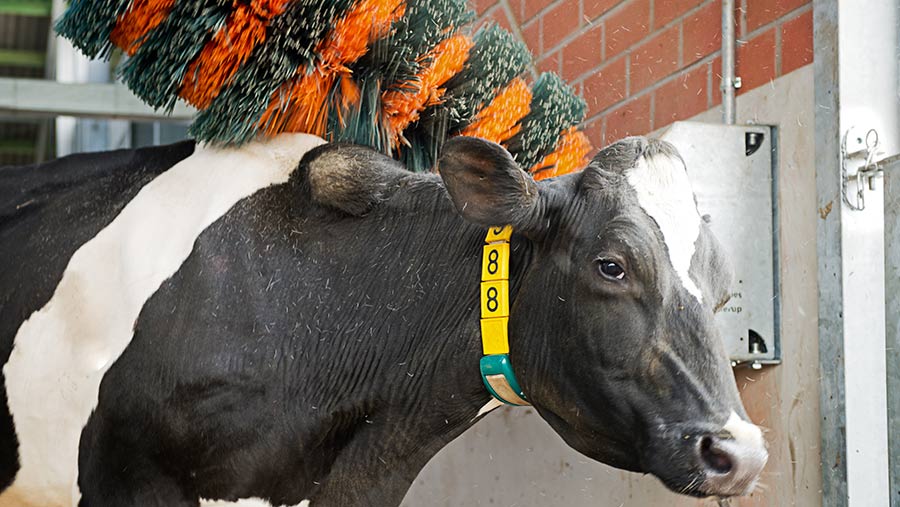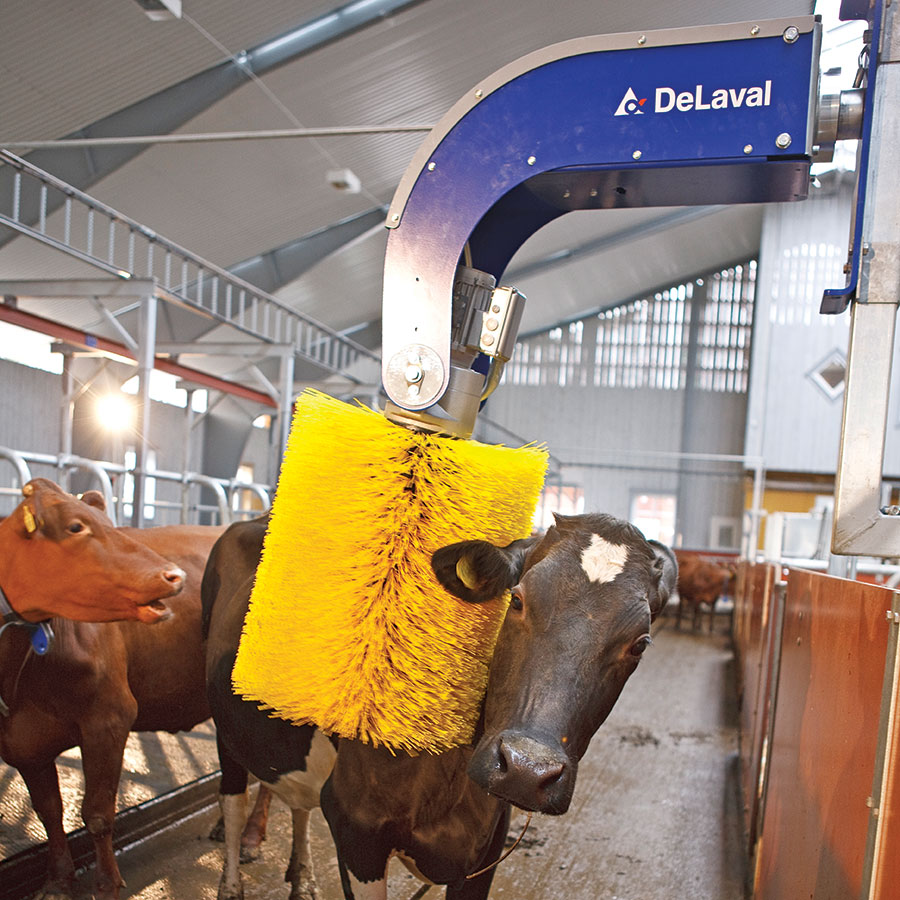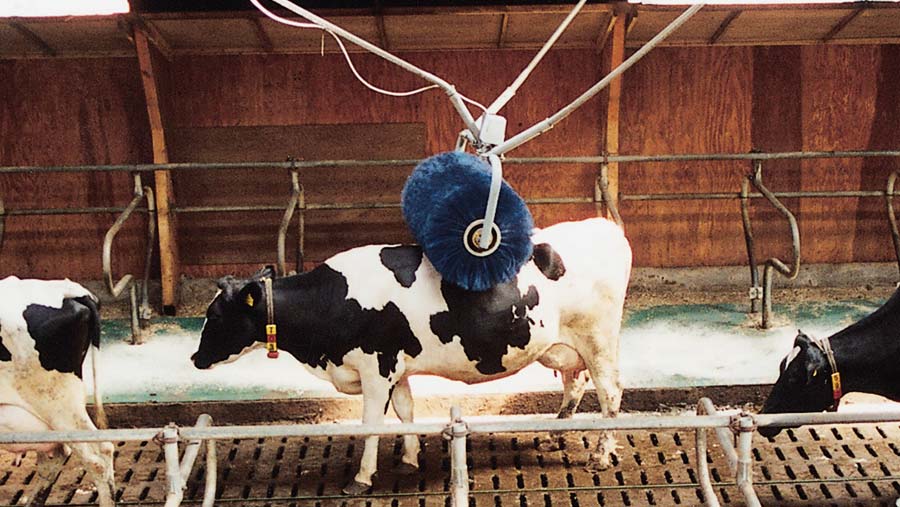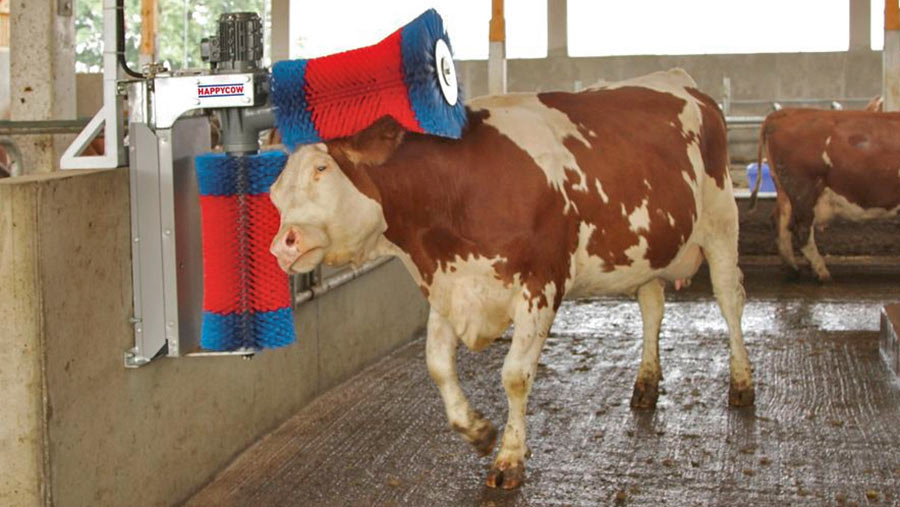Buyer’s guide: 5 of the latest cow brushes

Cows like a good scratch, so satisfying that instinct with a brush designed for the job can only be good for herd wellbeing.
A happy cow will always perform better, so dairy farmers who install brushes in housing might expect to recoup some of their investment through higher milk yields and improved performance overall.
Milk buyers also recognise the benefits of cow brushes as a means of promoting animal welfare to consumers, and some are now listing this form of enrichment in supply contracts.
See also: Buyer’s guide to automatic teat sprayers
As a result, manufacturers of dairy equipment are meeting demand by launching their own models.
We take a look at the different options and examine how some of the models on the market shape up.
What are the cow brush options?
Rotating brushes
A brush rotates on a horizontal arm attached to a motor and the motor also swings left and right, about 45deg in each direction.
The cow activates the rotation when she moves the brush, and this movement continues until the arm remains horizontal for a period of time.
Cows like these because they are easy to use and cover a greater area of their backs.
Some rotating models have two brushes, one horizontal and one vertical.
This type of brush tends to be among the priciest, but they don’t use a great deal of electricity, so savings can be made in energy costs.
Swinging brushes
Similar to the rotating model but the range of motion is greater – the brush can swing backwards, forwards and from side to side.
This provides a good level of grooming, although not a lot more than double rotating brushes.
The rotating starts when the cow pushes the brush and continues to rotate until it remains vertical for a period of time.
As with rotating brushes, the higher investment cost is offset by energy efficiency.
Stationary
The simplest concept of all – one horizontal brush and one vertical brush – it’s so simple, so not uncommon for farmers to make their own.
Some of the models available commercially have a spring that allows the horizontal brush to move, depending on the size of the cow. This makes them well suited to herds that have cows of different sizes.
One of the shortcomings of a non-mechanical, non-moving brush mounted on a wall or rail is that it doesn’t give all-round access, so it will service fewer cows.
The upside is the cost – expect to pay under £200.
What’s available on the market?

GEA E-Brush and M-Brush
Though there are many similarities between these two brushes from GEA, the E-Brush is a horizontal pendulum model and its compactness means it can be integrated into most livestock buildings. The M-Brush is angled, allowing cows to groom their sides and flanks as well as their backs.
Key features
- Different start-up directions reduce the wear and tear on the brushes
- Recommended cow to brush ratio of 50:1
- Will rotate for around a minute after the cow has activated the motor
- Comes with optional clamps and fasteners for clamping on to cubicle frames as well as wall-mounting
Pros
- A mixture of long and short bristles to maximise brushing efficiency
- Bristles are made from nylon for longevity
- Because the plastic shaft that holds the brush will break when it is overloaded it prevents damage to the brush and cow
Cost
- M-Brush: £1,964 ex VAT
- E-Brush: £1,630 ex VAT
DeLaval swinging cow brush SCB
DeLaval pioneered and patented the swinging cow brush, so the company has a good track record with this technology.

© Bjorn Qvarfordt/DeLaval International
The SCB is its third model. This one is designed with pivot points at either end of the curved arm to improve the grooming angles.
Key features
- Automatic on/off control starts the brush rotating on demand, and stops it within 10 seconds after use
- Swings freely in all directions
- Comes pre-mounted, so should be straightforward to install
Pros
- Will immediately stop if there is resistance
- Uses a third less energy than the previous DeLaval model
- The brush cylinder can be removed for cleaning or if it needs replacing
Cost
- RRP £1,600 ex VAT, but special offers available
MS Schippers skin grooming device
This nylon brush comes with the bonus of having equipment to automatically apply insecticides to treat skin disorders such as scabies, lice and flies.

Key features
- When the animal’s skin is irritated, it scratches the affected area on the upper brush and this releases insecticide
Pros
- The horizontal upper brush is attached securely by a solid spring and is resistant to mounts from animals in heat
- Durable nylon bristles
- Can be easily fixed to a wall or partition
Cost
- £155.50 ex VAT
Vink rotating livestock brush

This brush rotates to the left and right, not only to give a good brush effect but preserving the lifetime of the brushes.
Key features
- The brush starts to rotate as soon as a cow makes contact with it
- The combination of its springiness and long bristles prevents the cow being brushed too vigorously
- Can only be hung from a rafter
Pros
- The springy construction of the brush means it can withstand animals in heat and mounting each other
- The brush adjusts to the height of any cow
Cost
- £1,766.50 ex VAT. Available from suppliers including MS Schippers and Dairy Spares
Farm and Country Direct Duo Cow Brush

This double, wall-mounted cow brush automatically rotates when the cow pushes against it, scratching the top and sides of the animal at the same time.
Key features
- Made from galvanised steel with thick polypropylene bristles
- Very low maintenance with easily replaceable bristles
- A sensor switches the brush off if the tail gets caught
- Shaped and angled to scratch the back, tail, flanks and head
Pros
- The rotating time can be varied with setting times from 7.5 seconds to 120
- Easy to mount and ready to plug in
Cost
- £1,856 ex VAT
Considerations before buying
- Check if the brush model is suitable for use when cows are in heat. If heat detection methods like chalk tail paint are used, brush models that are not sprung can rub the chalk off; or in the case of fertility monitors, they can issue an alert for a cow without an actual mounting event taking place.
- Be mindful of letting a cow with horns near a brush; she will make short work of it.
- Get the location right – a lot of dust, dirt and hair is removed during brushing so siting a brush next to a water trough is not ideal.
- Consider cow flow – brushes can lead to bottlenecks at access points.
- Clean and maintain brushes regularly to extend their working life.
